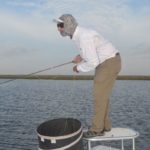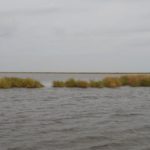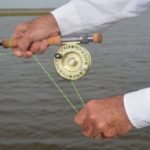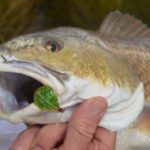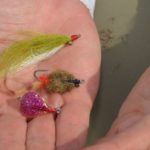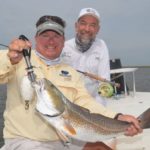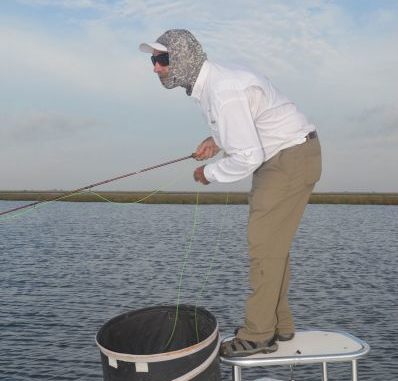
Vermilion Bay’s Marsh Island provides some excellent redfishing opportunities. Learn how this expert fly fisherman beat the conditions to boat these hard-fighting drum.
Keith Richard never had a chance at figuring out what was going on when he walked into Stillwater Outfitters fishing guide Steve Smith’s Cypremort Point camp.
The big kitchen was brightly lighted with photographic lights. Smith was perfuming the camp with sizzling bacon on the griddle. His wife Patricia was chopping ingredients for a salsa and humming to herself. (Their recipes are available in this month’s The Seafood Bible column, found elsewhere in the magazine.)
The lean 60-year-old fly fishing master had been invited by the charter captain to go on a fishing trip. This had to look a lot like a cooking party to him.
But he quickly adjusted, and the talk flip-flopped between fishing and food.
The charter captain had an ulterior motive in inviting Richard, who he called “a renowned fisherman and instructor.” Smith’s guiding specialties are speckled trout and redfish, typically caught with conventional casting and spinning tackle.
“I invited Keith,” he confessed, “to see how a master conducts himself so that I can better serve my customers. I’m interested in expanding my customer base to serve more fly fisherman.
“I am making a concerted effort to understand the needs of fly fishermen above and beyond what is required by conventional tackle users. It’s a lot harder to guide fly fishermen, especially when it’s windy.”
Richard’s reason for accepting the trip was simple.
“I take every opportunity to fish everywhere I can,” he said.
Their target was a small duck pond north of Lake Ferme on Marsh Island. Smith had located a concentration of redfish there several days before. It would be Richard’s first time to fish the big island south of Vermilion Bay.
Both men were looking forward to sight-fishing redfish in Marsh Island’s shallow ponds. Smith and partner John Garrison won Team of the Year in the 2013 Louisiana Saltwater Series redfish trail. All their fish were caught sight-fishing.
For Richard, sight-fishing “adds to the challenge of the hunt.” Calm weather conditions and a bright sunny sky is important to successfully sight fish.
The next morning was a long ways from perfect. An ugly chop disturbed the water on the run across Vermilion Bay. As the sun crept over the horizon, it inflamed the clouds with an ominous red hue.
Sailor take warning!
Smith cast a troubled eye on the water, but told Richard that things should be different in the protected lagoon of the island.
It seemed he was attempting to assure himself as much as Richard.
Smith’s shallow-water boat skimmed across several ponds and settled to a stop at the entrance to the one he planned to fish. At 8:15 a.m. it was still too early to effectively sight-fish, but even with the oblique light it was obvious that the men would have their work cut out for them.
The cloudy skies made the water appear leaden rather than green.
Richard looked over the bow area of the boat that he would be working from and nodded in approval. The ideal boat, he said, has no bow obstructions — running lights, cleats, or trolling motor. Hatch latches should be flush-mounted.
While Richard unlimbered his fly tackle, Smith buckled a casting platform to the bow deck. Its elevation would help the fisherman sight fish. A collapsible casting basket was set on the deck next to the platform.
“To a fly fisherman,” Richard said softly, “line control is paramount. With conventional tackle, the lure pulls the line out. In fly fishing, the line carries the lure to the prey. If you have a lot of slack anywhere in the line, you don’t have good control.
“Hence, the need for the basket: It keeps the line from getting tangled on anything in the boat.”
Smith moved the boat quietly with his 22-foot Stiffy push pole. Standing almost 4 feet above the boat’s deck on his poling platform, he gave assists to Richard in spotting fish.
The first fish was an easy one. Richard was able to spot him moving in the shallows, and the little guy inhaled the chartreuse spoon fly as soon as it passed near his nose.
The fish wasn’t a legal keeper, but no angler ever looked happier.
After releasing the fish, Richard explained that a traditionalist wouldn’t call a spoon fly a fly.
“He would consider it cheating,” he grinned.
Spoon flies are made of five-minute epoxy with gold or silver glitter in it and wire or mesh material.
“But,” he was quick to add to differentiate them from conventional tackle, “these are not Johnson spoons.”
Richard said a marsh fly fisherman’s arsenal should include three lures: topwater flies, subsurface flies and spoon flies, the latter two of which Richard went on to use during the day.
Subsurface flies come in minnow patterns (the most common of which is the Clouser minnow), crab patterns and shrimp patterns. For targeting trophy trout, some fishermen will use what is called a large “mullet fly.”
The specific fly chosen is determined by careful observation.
“Watch for bait sign — what is swimming or jumping,” Richard counseled. “Try to match what (redfish) are eating.”
The guide and the fisherman worked as a team. Sighting conditions were challenging. It was cloudy and windy, so the pair mostly hunted for sign: mud bombs (muddy swirls caused by fish tails), pushes (V-wakes made by a swimming fish’s back near the water surface) and tailings. In short, any disturbance including alarmed bait species’ movements.
The next redfish was bigger — a little over 5 pounds.
Smith spied it first and cued in Richard to its location. It was a long cast, so the angler had to strip a lot of line from the reel. This he did by waving his 9-foot wand backward and forward in false casts, stripping 5 feet of line from the reel each time.
The fly never hit the water until the last cast — the presentation cast.
Richard provided action to the lure by stripping the line back at varying speeds, mixing in some rod action, as well.
The master fly fisherman released this fish, as he did the next one, almost a duplicate of the second specimen.
“Most fly fishermen release all their fish,” Richard said. “They fish purely for the enjoyment of catching fish.”
There was a note of pride in his voice.
In spite of the drab day, Marsh Island was beautiful; a birder’s paradise.
Wiregrass dominated the marsh, and the ponds they were fishing in held patchy stands of wigeon grass that served to keep the water clear.
“The best thing about Marsh Island is that it gets very little fishing pressure,” Smith said. “Most of the fishing takes place on reefs around the island rather than in its shallow, protected ponds.”
Both men wore polarized sunglasses, a must for sight-fishing.
“Amber is the color lens you want in the marsh,” Richard stated firmly. “It shows up the colors of the bottom and fish better than any other color.”
While Richard wants to see the fish, he doesn’t want them to see him.
“I like light-colored clothing: white, blue or yellow,” he explained. “And if you noticed, Steve always tries to keep the sun at our backs.
“They can’t see you, and you can see them better.”
Watching Richard’s graceful moves on his casting platform was fun. It was almost too poetic to call it fishing ballet, but his smooth moves seemed almost choreographed.
Then, when a fish took the fly, the grace gave way to almost brute-force direct action.
With the rod offset slightly from being pointed directly at the fish, he quickly stripped all slack from the line and set the hook with a hard pull of the line with his free hand.
“The last thing you want to do is strike with the rod,” Richard grunted as he fought a vigorously protesting redfish. “If you point the rod right at the fish, it can break the line, but a 15-degree angle absorbs some of the shock.
The fight was also done differently than with conventional tackle. Richard never pointed the rod tip up, again keeping it pointed toward the fish but with the same 15-degree angle offset.
Smith’s Boga Grip showed the fish to be 9 ½ pounds.
Richard was to catch one more hefty redfish, almost as big as this one. Between the fish, he paused and summed up what fly fishing means to him.
“Fly fishermen expect to catch less than conventional fishermen do, but that is more than made up for by the satisfaction of executing a perfect cast and fooling a fish with a fly that I have tied.
“The pace of the fishing experience slows down when you are fly fishing. You can enjoy the beauty of the surroundings.”
Editor’s note: Capt. Steve Smith of Stillwater Outfitters can be reached at 337-654-3880.
